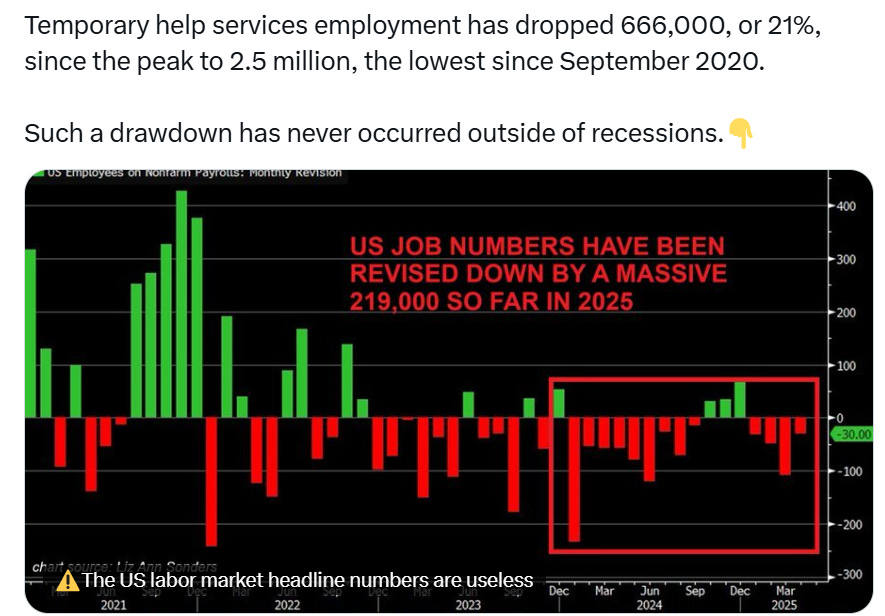Trillions for War, Pennies for the People—How Tech Giants, Endless Conflict, and Digital Distraction Are Dismantling the Nation
As the U.S. Jobs Mirage Collapses and the S&P 500 Soars on the Back of a Handful of Tech Titans, the Real Price of War, Homelessness, Addiction and Digital Addiction Is Paid by the Forgotten Millions
There is a dangerous disconnect between the official story of U.S. economic health and the reality facing millions of American workers. Since the beginning of 2025, the Bureau of Labor Statistics has quietly slashed its jobs numbers by a staggering 219,000—30,000 from April, 108,000 from March, 49,000 from February, and 32,000 from January, with 22 out of the last 28 months since 2023 also seeing downward revisions. This is not a statistical quirk; it is a pattern that reveals a labor market far less resilient than advertised.
Meanwhile, the S&P 500—often touted as the barometer of American prosperity—is increasingly a mirage, propped up by just seven technology giants: Meta, Apple, Netflix, Google, Microsoft, Amazon, and Tesla. Their combined weight is so outsized that their fortunes dictate the overall market mood. Tesla, the lone automaker in this elite group, is a particularly egregious outlier. Its market capitalization now exceeds $1 trillion—more than the combined value of Honda, Toyota, General Motors, and Ford.
Yet, when measured by actual sales, these legacy automakers outsell Tesla by a factor of nearly 40 to one. Tesla sold just 1.8 million vehicles in 2024, compared to 68 million sold by the top 15 global automakers, exposing a chasm between stock market euphoria and real-world performance.
This market distortion is not just a matter of valuation. It reflects a broader shift in the American economy, where the promise of technological innovation has become a justification for job destruction. Google, Microsoft, and Apple—pillars of the S&P 500—are all aggressively cutting jobs, often under the guise of efficiency or “organizational streamlining.” In June 2025, Google offered buyouts to employees in its core search, ads, and engineering divisions, signaling a new wave of downsizing.
Microsoft, fresh from reporting record profits, laid off 6,000 workers—about 3% of its global workforce—with CEO Satya Nadella openly stating that up to 30% of the company’s code is now written by artificial intelligence. These cuts are not cyclical; they are structural. Microsoft’s CTO has even predicted that, by 2030, AI could write 95% of the company’s code. The message is clear: if machines can do the work, why pay people?
Apple, too, has been quietly reducing headcount, though it prefers to avoid the public spotlight. The result is a tech sector that is more profitable than ever, but employing fewer Americans than it did just a few years ago. The layoffs are not confined to Silicon Valley. Across the broader tech industry, more than 22,000 workers have lost their jobs in 2025 alone, with tens of thousands more cut in 2024.
What does this mean for the average American? The stock market’s relentless rise is not translating into widespread prosperity. The S&P 500’s gains are concentrated in a handful of companies, while the labor market’s underlying strength is being quietly revised away. The government’s own data shows that job growth has been overestimated, and the pace of hiring is slowing. The promise of a “soft landing” for the economy is increasingly at odds with the lived experience of workers facing job insecurity and stagnant wages.
The tech giants may be writing the future, but for most Americans, that future looks increasingly precarious. The stock market’s celebration of AI-driven productivity gains is a hollow victory if it comes at the cost of mass layoffs and a shrinking middle class. The question is not whether the S&P 500 will keep rising, but for whom—and at what price. The real story of the American economy is not being told in the headlines, but in the fine print of the jobs reports and the quiet exits of workers who once believed in the promise of progress.
The Costs of War Project at Brown University, a prestigious and nonpartisan research initiative, reveals the staggering price tag of America’s post-9/11 wars: over $8 trillion—a figure that includes both past expenditures and future obligations for veterans’ care, homeland security, and interest payments.
The war in Afghanistan alone cost $2.3 trillion, with operations in Pakistan and reconstruction factored in. Meanwhile, the U.S. has committed over $185 billion in aid to Ukraine since 2022, and billions more annually to Israel, though exact totals for Israel are complex and politically contentious. For context, U.S. military aid to Israel—including annual security assistance and special packages—has exceeded $150 billion since its founding, with yearly aid now around $3.8 billion, and additional billions in emergency appropriations during recent conflicts.
While these vast sums are allocated abroad, the nation’s streets are ravaged by a homelessness crisis: over 771,000 Americans were recorded as homeless in 2024, the highest ever tally, with a shocking 18% increase over the previous year.
In cities like Philadelphia, open-air drug markets sprawl for over a square mile, with dealers hawking crack and meth as openly as hot dog vendors at a ballgame. Homeownership is now a pipe dream for most: 75% of U.S. households cannot afford a median-priced new home, priced out by soaring costs and high mortgage rates. Skyrocketing medical expenses—projected to rise nearly 8% in 2025—are overwhelming families and employers alike.
America’s youth are not spared. Academic performance is in free fall: U.S. students rank in the 20s globally in math, with test scores plunging and achievement gaps widening. The digital age has eroded social skills, as children and teens, glued to their phones, struggle with face-to-face interaction and emotional intelligence.
The average American now spends over seven hours a day on screens, with smartphones and streaming services dominating leisure time. Apple, as the country’s top company by market cap, symbolizes this paradox: everyone has a phone, but fewer can do basic fifth-grade math.
The relentless barrage of ads—"Come to AT&T and get 5 iPhones FREE!"—epitomizes a culture of distraction, where digital addiction is normalized and even celebrated. Streaming, gaming, and social media are the new pastimes, but at what cost? The nation is becoming a society of digital slaves, distracted from the real crises at home while trillions flow abroad and social fabric unravels. The correlation is clear: as war spending balloons and social safety nets fray, the American public is left to navigate a landscape of digital delusion and real-world decline.
The sword of militarism cuts both ways—while Washington claims to defend democracy abroad, it is in fact operating in a full-on war profiteering mode. As Jason Ma reported in Fortune on August 17, 2024, Palantir CEO Alex Karp warned that the U.S. will likely face a three-front war against Russia, China, and Iran, urging the Pentagon to accelerate autonomous weaponry and prepare for unprecedented global conflict. This rhetoric is not just about national security; it is a clarion call for more contracts, more spending, and more power for the military-industrial complex that already dominates American foreign policy.
When private banks and the Federal Reserve fund the Treasury, the first bill paid is to the Pentagon, enabling it to roam the world and enforce dollar hegemony—sometimes by force. The result? Most taxpayer dollars are funneled into a system that strangles workers at home while enriching defense contractors abroad. The average American now gives $5,109 a year to militarism—more than their monthly rent—while public services like healthcare, education, and housing are starved. The Pentagon has never passed an audit, yet its budget swells year after year, even as programs for veterans, children, and the mentally ill are slashed.
The true measure of this betrayal is the collapse of the dollar’s purchasing power since the Federal Reserve’s creation in 1913. Back then, $100 could buy a month’s worth of groceries for a family; today, it barely covers a single bag. In 1913, $100 was worth $100; by 2025, it is worth just $2.90—a staggering 97% loss of value. This is the cost of endless war, corporate welfare, and a government that prioritizes bombs over bread.
It is time to crush the head of the serpent—to demand accountability, transparency, and a reallocation of resources from war profiteers to the working people whose labor built this nation. The choice is stark: continue down the path of ruin (decline and distraction,) or reclaim the promise of American prosperity for all.
Artist rendering Mary the Mother of God crushing the head of a serpent
https://en.wikipedia.org/wiki/Miraculous_Medal










